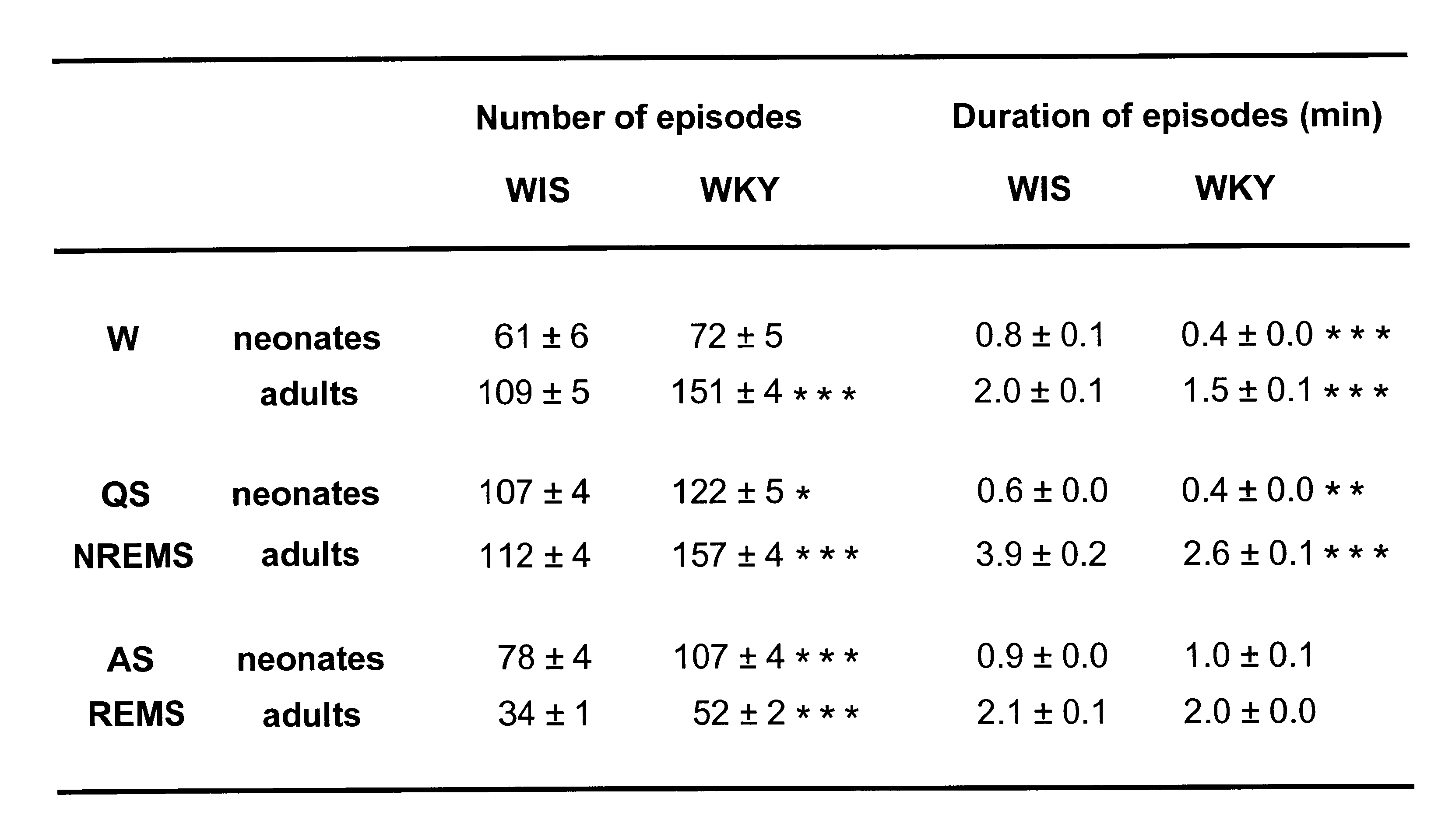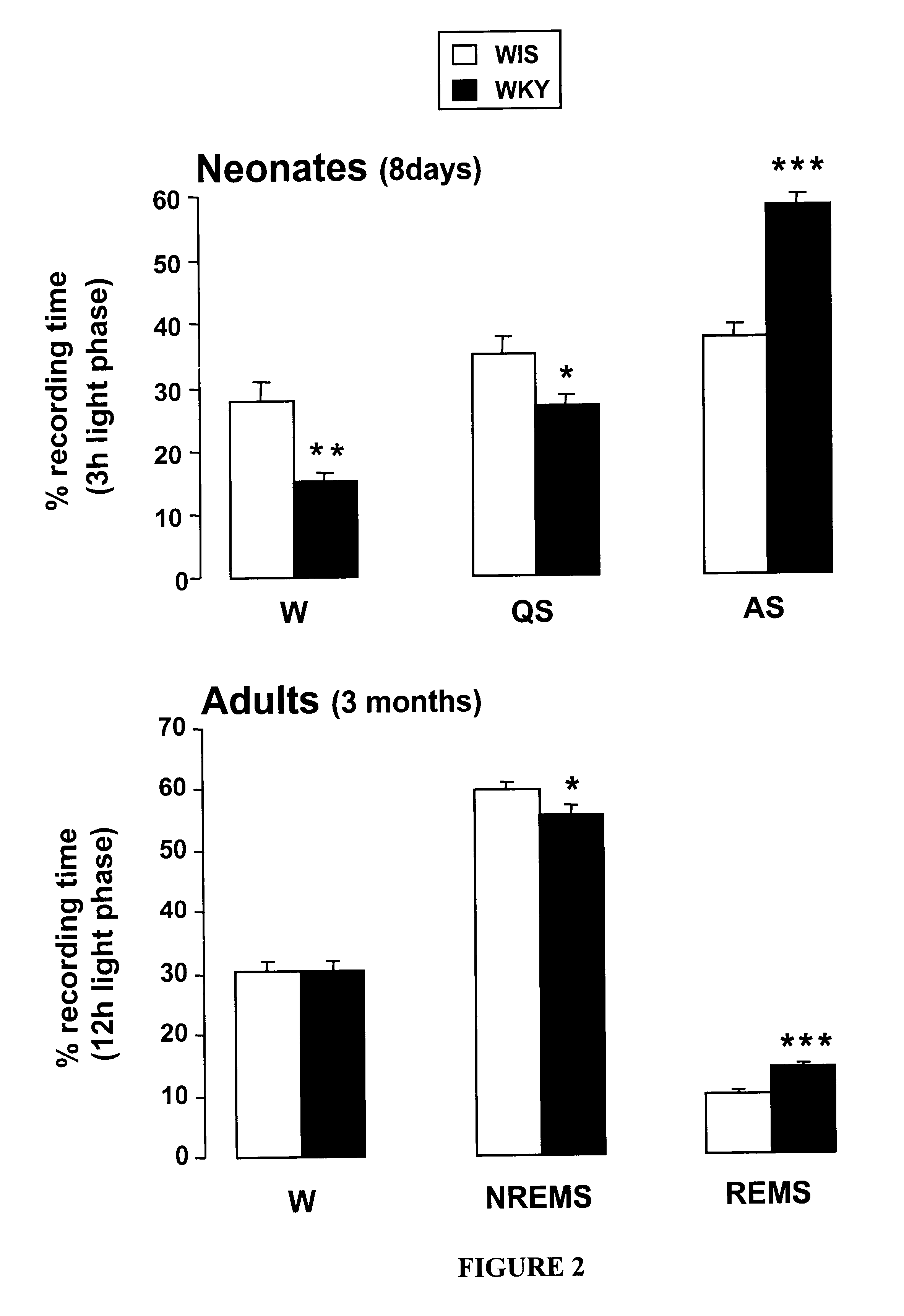Analysis of muscular activity in neonatal animals to screen for mutations and/or drugs that alter sleep and wake states
a technology of muscular activity and neonatal animals, applied in the field of analysis of muscular activity in neonatal animals, can solve the problems of difficult, at best, to screen a large number (up to thousands) of animal subjects, and it is expensive and time-consuming to record eeg and emg sleep from a large number of animals, so as to enhance the ability to find and improve the ability to detect.
- Summary
- Abstract
- Description
- Claims
- Application Information
AI Technical Summary
Benefits of technology
Problems solved by technology
Method used
Image
Examples
example 1
To record neonatal vigilance states, the pups are separated from their mother for 3 hours, a time-period short enough not to cause any major decrease in the amount of AS (Hofer, 1976). Just before the sleep recording the pups are removed from the home nest (2-3 pups per litter). The pups are placed in an acrylic chamber containing home cage bedding material placed on an electrical incubator adjusted at a temperature of 32.degree. C. Two muscular electrodes are temporally placed only for the duration of the recording. Teflon coated multistrand wires (from Medwire, Mount Vernon, N.Y.) composed of 10% iridium and 90% platinum (coated diameter 0.007 inches and bare diameter 0.005 inches) are used as electrodes. The combination of the chemically neutral platinum with iridium is combined with Teflon insulation. The wires are rapidly inserted across the nuchal muscle using a 21G hypodermic needle as a guide. The internal part of the wire of about 5 mm length is uninsulated to allow the ele...
example 2
Pregnant female WKY and control WIS rats (n=3 of each strain, from Harlan Netherland) were maintained under standard environmental conditions (12:12 h light-dark cycle, 22.+-.2.degree. C. ambient temperature, food and water available ad libitum). At birth, pups remained with their litter and at 8 days of age 2-3 male pups from each litter were selected for the study. To record neonatal vigilance states, pups were removed from the home nest and placed in a recording chamber containing home cage bedding material. During maternal separation body temperature was maintained by an electrical incubator adjusted to a temperature of 32.degree. C. The behavioral states of vigilance were differentiated by recording EMG activity with electrodes temporary fixed in the nuchal musculature only for the duration of the recording. Although EEG activity appears undifferentiated in the early postnatal period, the precursor forms of behavioral sleep states, AS and QS, can be accurately differentiated in...
example 3
Polygraphic recordings in neonates were visually scored by 15 sec epochs and classified as being wake (W), quiet sleep (QS) or active sleep (AS). FIG. 3a illustrates the characteristics of the different vigilance states based on EMG recordings from 8-day old rat pups where W is identified by high amplitude EMG activity, QS by very level of EMG activity and AS by absence of muscular tone punctuated with frequent muscular twitches. In adults, polygraphic recordings were classified as either wake (W), non-rapid eye movement (NREM) sleep or rapid eye movement (REM) sleep according to standard criteria (W, low-voltage fast EEG activity and high EMG activity; NREM sleep, high-amplitude slow cortical waves and low EMG activity; REM sleep, low-voltage fast cortical waves with a regular theta rhythm and absence of muscular tone). ANOVA was used to measure statistical differences in the sleep-wake parameters between WIS and WKY rats, as neonates and as adults. Subsequently, the unpaired two-t...
PUM
 Login to View More
Login to View More Abstract
Description
Claims
Application Information
 Login to View More
Login to View More - R&D
- Intellectual Property
- Life Sciences
- Materials
- Tech Scout
- Unparalleled Data Quality
- Higher Quality Content
- 60% Fewer Hallucinations
Browse by: Latest US Patents, China's latest patents, Technical Efficacy Thesaurus, Application Domain, Technology Topic, Popular Technical Reports.
© 2025 PatSnap. All rights reserved.Legal|Privacy policy|Modern Slavery Act Transparency Statement|Sitemap|About US| Contact US: help@patsnap.com



